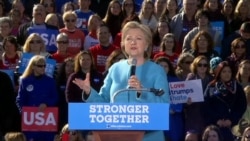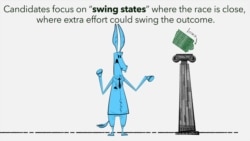In U.S. presidential politics, not all states are treated equally. In the final days before the November 8 election, Democrat Hillary Clinton and Republican Donald Trump are focused on a small handful of so called “battleground” or “swing” states that will determine who will be the next president of the United States. About two-thirds of the 50 states generally lean toward one party or the other, leaving a dozen or so states that are up for grabs every four years.
The U.S. elects a president through the state-by-state accumulation of votes through the Electoral College, where the candidate who wins the popular vote in a given state is then awarded all of that state’s electoral votes. There are two minor exceptions in Maine and Nebraska where some of the electoral votes are awarded by congressional district.
In the final days of the campaign, Clinton and Trump repeatedly target the same handful of states, which is why both White House hopefuls are making frequent visits to Ohio, Florida and North Carolina and small groups of other states that loom pivotal on election day.
Red, blue and swing states
For several years the United States has been sharply divided politically, with many states in presidential elections leaning toward one party or the other. “In many states, one party has a very big lead and there is no sense in spending a lot of resources at the presidential level in that state,” said Georgetown University analyst Stephen Wayne.
That leaves about a dozen so-called “battleground” or “swing” states where Trump and Clinton spend most of their time, said George Mason University expert Jeremy Mayer. “In the modern presidential campaign, you run campaigns only in about 12 states. The list can change from year to year, although in the last three election cycles, it is fairly stable.”
The swing states that get the most attention include large states like Florida, Ohio and Colorado, as well as smaller ones like North Carolina, Virginia, Iowa, Nevada and New Hampshire. And Mayer adds voters in those states get the brunt of the political ad blitz. “It makes those 12 states really the targets of this whole election discourse. So both campaigns in a normal year would have massive ground operations, would have endless TV ads and would be phone-calling and robot-calling voters in those 12 states.”
This year, the Clinton campaign is trying to make history by expanding the competitive map to historically Republican states like Arizona, Georgia and even Texas. Polls show a fairly close race in Arizona in particular and Clinton is within striking distance in both Georgia and Texas. Arizona last voted for a Democrat in 1996 and Texas supported Democrat Jimmy Carter back in 1976.
WATCH: Swing states explained
Democrats' electoral advantage
Since the 1992 election won by Bill Clinton, Democrats have been able to count on winning 18 states plus the District of Columbia, with a combined total of 242 electoral votes. Remember, it takes 270 out of the 538 electoral votes to win the presidency.
Republicans, on the other hand, have been able to count on 13 mostly smaller states with a combined electoral vote total of just 102. The remainder are the so-called “battleground” states where the election outcome is usually decided.
Clinton’s battleground edge
This year, Hillary Clinton and the Democrats appear to have a decided advantage with Clinton leading in key states like Colorado, New Hampshire and Virginia and battling Trump in close races in Florida, North Carolina and Ohio.
This year’s Electoral map has put Trump at a disadvantage, said American University analyst Austin Hart. “He’s got to win voters in Florida, Ohio, perhaps Colorado and Nevada. He’s got to shore up things in Pennsylvania if he can. So he has a heavy load in front of him.”
Most of the scenarios that would project a Trump victory involve him winning most of the swing states up for grabs including Florida, Ohio, North Carolina and even Pennsylvania, which has not voted for a Republican presidential candidate since 1988.
Declining white vote
Changing demographics also loom as a growing challenge for Republicans. White voters are likely to make up about 70 percent of all voters in this year’s election, as the country continues to diversify. In 1980, whites made up 88 percent of the electorate. The Cook Political Report also notes that in 1980, Republican Ronald Reagan won 56 percent of white voters and won in a landslide. In 2012, Republican Mitt Romney improved on that number. He won 59 percent of white voters, but lost to President Barack Obama by four points overall.
Republican strategist John Feehery sees the two parties headed in different directions. “It is a liberal, progressive party of coalitions, ethnic coalitions. And the Republican Party is a coalition of basically white voters of various stripes of conservatism.”
Targeting undecideds
In the final days of the campaign, the candidates will target a relatively small group of voters in a handful of states where the election hangs in the balance. “The question is now that sliver of independents,” said American University analyst Jennifer Lawless. “But it’s not only the sliver of independents. It’s smaller than that. It’s the sliver of independents who live in battleground states. So we are talking about a very, very small percentage of the population.”
Americans are now making a final decision between two flawed candidates in one of the most divisive elections in U.S. history, and the focus remains on a handful of states that will likely determine the outcome.































